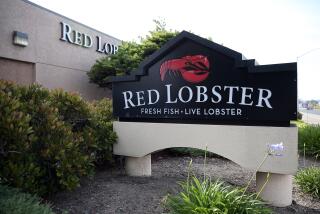Rusty Pelican Lays Off 3 Executives : Firm Plans Restructuring, Other Cost-Cutting Moves
- Share via
In a management shake-up unprecedented in its 18-year history, Rusty Pelican Restaurants Inc. on Monday laid off three of its five corporate vice presidents and announced a corporate restructuring and a reduction of its expansion plans.
The unexpected move is a bid by the Irvine-based chain of seafood dinner houses to cut costs and keep from raising prices, said T. Randolph Howatt, president and chief operating officer. Rusty Pelican operates 19 restaurants in seven states, including five in Orange County.
“The days of simply passing on menu price increases to the consumer are over,” Howatt said. “We needed to take bold steps to ensure the company’s future.”
In all, Monday’s actions affected seven management employees, including four who were reassigned. Howatt said no layoffs are planned at the restaurant level, where more than 2,000 are employed.
Could Show Improvement
He said the corporate belt-tightening should help the company show improvement in its fiscal 1987. But Rusty Pelican could post a “small loss” or break even for its fiscal 1986, ended Aug. 3, Howatt said. The annual financial results are expected to be announced later this month. In its fiscal 1985, the company had net earnings of $2.25 million.
Because of the disappointing year, Howatt said the company has revised its fiscal 1987 growth plans and now expects to open just four restaurants instead of the previously planned six units.
In its fiscal 1986 third quarter, Rusty Pelican posted a loss of $512,000. Although its restaurant operations were profitable, the company took write-offs for abandoned development plans and accounting changes.
Monday’s layoffs--aimed at shaving money from the payroll without reducing the service-level staffing--hit corporate vice presidents Larry Zwain, marketing; Doug Davidson, real estate, and Tim Aspel, human relations. Their duties will be assigned to other senior managers, Howatt said.
Financial Pinch
Rusty Pelican is not the first operation to feel the restaurant industry’s present financial pinch, analysts say.
One reason for the financial struggles at a number of restaurant chains is the flood of new competitors that have entered the market in recent years. Today, for example, the nation has an average 4.1 restaurants per 1,000 people, compared with 2.6 per 1,000 just a decade ago, according to industry estimates.
Odd as it sounds, the popularity of home video recorders also is hurting the dinner restaurant industry, Howatt said.
“More and more consumers are spending their evenings at home watching their VCRs and munching on take-out food,” he said.
The restaurant situation, however, is not yet critical, said Robert Patterson, managing partner of the Los Angeles office of Laventhol & Horwath, an accounting and consulting firm. “In general, the industry position seems to be getting more conservative each year,” but nothing overly dramatic is about to happen, he said.
At Rusty Pelican, Patterson said, the cutbacks are simply moves “to make sure they don’t have too many down quarters.”
More to Read
Inside the business of entertainment
The Wide Shot brings you news, analysis and insights on everything from streaming wars to production — and what it all means for the future.
You may occasionally receive promotional content from the Los Angeles Times.










